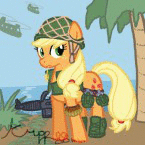rader
Posts: 1238
Joined: 9/13/2004
Status: offline

|
Ok, his invasion did after all turn out to be a feint. A feint of nothing more than a bunch of unloaded LCTs, at least on AK, and an ancient CL. The rest seem ot have returned to Bihoro. It wasn't much, but of course it was enough to lure 600 Japanese planes to thir death under a blanket of allied figthers 
I think doing this kind of thing is at least midly abusive of the naval strike targetting routine, so it generated a back and fourth of friendly emails which I thought I should post to explain the situation. I got Greyjoy's persmission to post these. I'm curious what people think about this.
/////////////////////////////////
Me:
I thought you might try something like this eventually. I'm not angry at you or anything, but I do think it is kind of abusing the code to send a large number of worthless ships to loiter at one of my bases under heavy LRCAP. I know we both take advantage of stupid naval strike targeting to some extent. I also know that in RL the allies were planning to lure Japanese strike aircraft out before an invasion to try to shoot them down. But the difference is that the allies were going to use some real bait like CVs and battleships loaded with anti-aircraft guns and fighters - which were actually valuable targets in themselves and prone to draw a large strike. Moreover, the Japanese were very much aware of the scheme, and were planning to be very careful to save their strike aircraft for legitimate targets (although I agree that FOW would play some role in creating uncertainty as to what was a legitimate target). In a situation like this, it would have been pretty obvious to the Japanese that the gaggle of small ships at anchor offshore buzzing with fighters was a trap - at least after the first strike went in. I can possibly imagine a small Japanese strike getting sucked in, but I can't see the Japanese sending piecemeal wave after wave for 2 days vs. such a target in light of the losses. It's even worse than that, because while a valuable target draws a large strike that tends to get through intact, small targets tend to draw many small strikes, which as we've seen, incur disproportionate casualties and have basically no chance of inflicting any damage.
I wish there was some switch on strike aircraft where you could set some kind of conditional attack orders ("attack only CVs/BBs/invading ships/etc., or "don't attack ships with heavy fighter cover"). But there isn't, and in these situations, I have no choice. I have to choose to give naval attack (letting something like this happen) orders or not (letting legitimate threats saill by with no response). If I choose to set them to react, then my (very stupid) computer commanders are perfectly happy to send in wave after wave to get slaughtered against worthless targets with strong CAP who clearely aren't posing any threat. There is no particular reason you couldn't repeat such an excercise indefinitely.
This is bad enough when it takes place at your own base: i.e., leaving a bunch of useless targets at your own base under fighter cover to suck in enemy strikes. This is something we both do, because we know that the other side can't set aircraft to strike with ranges that would include heavily protected enemy bases so long as there are at least a couple of worthless target ships there. Naval strike assignment will hapily send in naval strikes vs. thse worthless targets until you run out of aircraft. Thus, effectively, you can't conduct naval strikes on enemy TFs at a range longer than the nearest heavily CAPed base. The situation gets sillier when you send worthless target ships to open ocean hexes with heavy CAP. This allows you to 'surprise' enemy strike aircraft that are already set with naval strike orders and compel them to impale themselves on your CAP. But it seems to me especially silly to send worthless ships directly into enemy bases with heavy LRCAP to compel enemy strike aircraft to impale themselves.
Again, I'm not mad at you, I just wanted to raise the issue with you and get your thoughts. If you had sent battleships, CVs, lots of big transports (even unloaded), or something like that to one of my bases (i.e., something that would look like a "real threat"), I don't think there would be an issue. I think the issue is only when we use obvisouly worthless ships to compel naval strikes to impale themselves without risking anything valuable. This seems a lot like abusing the code to me.
//////////////////////////////////
Greyjoy:
I can agree with you on certain degree but this isn't exactly the case imho. Under my point of view this was a "good" elaborated and complex feint. Wasnt' just sending useless ships to an enemy base. I tried to lure you under the perception that i was invading exactly that day (fake loadings and fake movements from Bihoro to Kushiro, troops strat moving up and down in Hokkaido etc) - btw i cannot understand your lack of naval search assets in my waters...my ships were moving completely undetected...-
And i took great risks to mount this feint cause my ships had to stay in ocean waters - but in range of your naval bombers - without any cover to make you believe i was really moving to invade. If i hadn't done that you would have simply waited not risking you precious bombers.
We've done the so called CAP traps for the whole game...it's part of the game mechanics and i don't think there's any difference to place a CAP trap with a fake invading convoy or a CAP trap at one of my own base in a crowded environment like the solomons for example.
My opinion is that it's part of the game. Many many times i have to costrain myself not to place my bombers on naval strike in range of your bases for the same reason.
In this environement, like Okkaido-Honshu...where our bases are so close to each other...CAP traps are a risk we both run when we decide to set our bombers on naval strike.
It's the very same issue of picket TFs (that i learnt to use from you :-) ) and other things like that.
However...as you might guess my opinion is different from yours on this specific point.
But i understand you are pissed (i would be very pissed if i was you).
Should we HR this for the future? What would be a "fair" HR in your opinion?
//////////////////////////////
Me:
I have Japanese coastwatchers at Kushiro and Bihoro (actually every port in Hokkaido I think) that report all your naval presence at these ports every turn with pretty good acuracy. I was watching your load up and move with great interest (and my recon over your base helps too). I thought it was about 30% likely you would invade somewhere (and probably Hachinohe because it is clear terrain, closer to your bases than Akita, and you've been giving it a lot of attention recently). But I thought more likely it was a feint of some kind, and I actually thought there was a very good chance (maybe better than 50%) chance that you would invade down the coast at Sendai or something, or along the North coast. Thus I have to stay alert and defend everywhere. And it is true that I can see you put a lot of effort into a deception with all these movements (I saw the number of units at Bihoro go from 175 to 130, telling me you were loading up 2 turns ago and then moved to Kushiro with a big invasion force). And that's the main reason I'm not actually angry about it: you did set up a good feint. I thought there was a good chance it WAS a feint, but prudence demands that I take such moves seriously nonetheless.
The problem is that there is absolutely no way I can tell the difference between a feint and an invasion during the time I need to give orders. It only becomes clear when the turn runs. Therefore I can either give orders to my bombers to strike, or not to strike. Then you can choose to either sail in with real targets or just a bunch of crappy ships. I don't see why you wouldn't just keep doing the same thing with useless ships every turn. Eventually I will have to stand down my bombers. And then you are free to invade with no risk of intervention. This is extremely abusive, because the fact is that the naval strike commanders would/should make a judgement of whether or not the target is worth risking the strike, and the computer frankly does a terrible job of this. What you did was a historically planned ploy, however what is not modelled is the fact that the Japanese were aware that the allies would try such a thing and decided not to send their bombers after the first allied ships spotted, but would hold them back until it became clear that an invasion was actually taking place. If I could set my bombers to "don't attack unless you spot CVs, or the allies actually land troops ashore" (the actual "historical" setting) of course I would. I feel that you are taking advantage of the fact that I can't do this. I do think the CAP trap thing at your own bases that we both is bad enough and I wish it wansn't part of the code. But what you should do now, is keep a constant presense of crappy ships at all my northern bases so that I can never set naval strike orders. And then you can just wait until my bombers are stood down and invade without facing any possibility of naval strike. Absolutely crazy.
I can live with not being able to set naval bombers with attack orders in range of your bases. But I do think that naval bombers ought to be able to cover my own bases without much chance of sacrificing themselves in droves for no reason against useless targets. The crux of the matter here is that there is no player control over the decision of what types of targets to strike, and the AI does a horrible job at handling this.
As for HRs, I think this falls more under the "don't do things to intentionally abuse the code", but since I prefer concrete rules to general guidelines, I'm not really sure of what would be specific enough. As I said, I think feints to lure out bombers to die under CAP are probably ok, provided the threats are "credible enough" and the targets are reasonable ones that the bomber commanders would decide to actually go after. To some extent, I think the situation does fall under our existing HR about not using tons of small ships to confuse the targetting routine, but this isn't perfect.
I am tempted to say that you shouldn't be able to remain on station at an enemy base, but it's not really the base part that's a problem. If you had done it one hex offshore, I don't think it would be any better.
I think basically CAP traps for naval strikes is a whole different situation from CAP traps for bombing ground targets. This is because any time you bomb ground target (airfield, city, port, land unit), you have complete control of which hex you fly to and thus choose if you want to brave the CAP or not (and you can even fly right over tons of CAP to hit a base in the rear). But with naval strikes, your stupid AI commanders make the decisions of whether to brave the CAP or not, and the targets move during the turn resolution.
Unfortunately, all this makes it hard to come up with a single rule that would prevent abuses. But it would be something like not being able to use CAP traps for naval strikes outside your own bases unless you include air combat TFs with a certain # of aircraft in the CAP trap or be actually conducting a "serious" invasion. I suppose you could add LRACP from air bases or whatever. This being, the only way the allies would have actually used naval strike CAP traps in real life (and did actually do so at Formosa) was to use carriers to run the CAP. This is because without the "real" threat, the strike aircraft could simply decide not to fly - but you don't have the option in the game :(
The problem with something like this is that it leaves open the definitions of what is a CAP trap, and how do you define a "real" threat or "serious" invasion.
And again, I'm really not mad at you and I don't think you thought you were abusing the rules too badly today. It's just that it is a particular weakness in the rules that you can actually just totally nullify any ability I have to defend my bases by consistenly doing these types of "feints" every turn -- indeed sitting directly in my bases with tons of crappy ships until you want to actually invade. And there aint a damn thing I can do about it. I can't issue orders to my commanders to be more cautious, or really do anything differently at all - apart from telling them to ignore any invasion and let the allies land for free.
|
 Printable Version
Printable Version
































 New Messages
New Messages No New Messages
No New Messages Hot Topic w/ New Messages
Hot Topic w/ New Messages Hot Topic w/o New Messages
Hot Topic w/o New Messages Locked w/ New Messages
Locked w/ New Messages Locked w/o New Messages
Locked w/o New Messages Post New Thread
Post New Thread